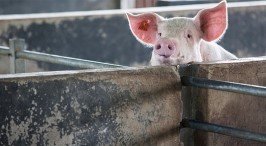FAO convenes emergency meeting to address ASF in Asia
Meeting will establish regional stakeholder network with defined roles and responsibilities.

The U.N. Food & Agriculture Organization (FAO) has opened a three-day emergency meeting to examine the most recent developments following the outbreak of African swine fever (ASF) in China and propose a regional response to the threat that ASF could spread to other countries in Asia, according to to an announcement.
The meeting comes as China reported to the World Organization for Animal Health (OIE) the detection of a ninth case of ASF in Heilongjiang province in far northeastern China.
The specialists directly involved with regulatory aspects of disease prevention and control planning — veterinary epidemiologists and laboratory experts, as well as other senior technical staff — are drawn from 10 countries with geographical proximity to China that are perceived to be at risk of a transboundary spread of ASF. The participants are from Cambodia, China, Japan, Laos, Mongolia, Myanmar, the Philippines, Republic of Korea, Thailand and Vietnam. Experts from outside the region will also attend, as will participants from the private commercial swine sector.
ASF outbreaks have occurred in Europe and the Americas from the 1950s through the 1980s. However, in 2007, a new introduction of ASF occurred in the Republic of Georgia, which then spread to neighboring countries and deeply affected Eastern Europe. Romania's pig farming sector is currently being hit the hardest, while other European countries are mostly dealing with cases in wild boars.
ASF new to Asia
In Asia, ASF was first detected at a pig farm in the Siberian region of the Russian Federation in March 2017, FAO said. The virus was discovered in northeastern China at the beginning of August this year. Since then, multiple additional cases have been reported in other areas of China up to 1,000 km apart.
China produces more than half of the world’s pigs, and while ASF poses no direct threat to human health, it can devastate the swine population, FAO said. In its most virulent form, it is 100% fatal to the animals that contract the virus.
As of Sept. 5, to contain its spread within China, the authorities have culled as many 40,000 pigs so far, FAO said. Representatives from China will update the meeting on the latest numbers and actions being taken within the country.
Coordinated regional response
“It’s critical that this region be ready for the very real possibility that ASF could jump the border into other countries,” said Wantanee Kalpravidh, regional manager of the FAO Emergency Centre for Transboundary Animal Diseases in Asia. “That’s why this emergency meeting has been convened: to assess where we are now and to determine how we can work together in a coordinated, regional response to this serious situation.”
In order to reach a consensus on the way forward, this emergency meeting will also review recent research studies and technologies and consider lessons from the most recent and ongoing episodes of ASF in Europe in the aftermath of its introduction since 2007. Representatives from OIE will also participate.
“It’s very important to understand how this virus has spread, historically, within the pig and wild boar populations in other regions of the world so that we can adapt and tailor appropriate responses and determine the correct course of action needed here in this region,” FAO chief veterinary officer Juan Lubroth said. “Perhaps more critical in terms of risk is the likely role of pork and pork product traffic through production and market chains — whether fresh or cured commodities.”
“The fact this emergency meeting of experts from Asia and beyond has convened as quickly as it has is emblematic of the concern our member countries have over this outbreak and the very real threat it poses to their livestock, their national food security and the livelihoods of millions of people along that value chain,” added Kundhavi Kadiresan, FAO assistant director-general and regional representative for Asia and the Pacific. “FAO will continue to support this response in every way we can.”
FAO said the emergency meeting will conclude Sept. 7 with the establishment of a regional stakeholder network with defined roles and responsibilities. It’s expected that the teams will identify and prioritize the actions that are required for countries to take in the short, medium and longer term.
About the Author(s)
You May Also Like



